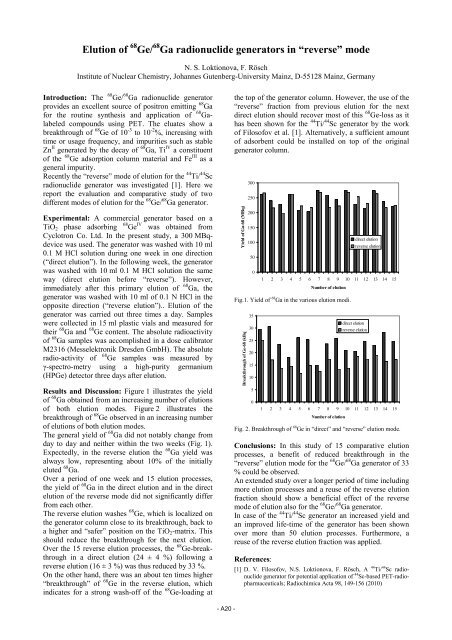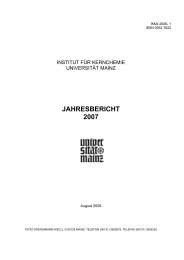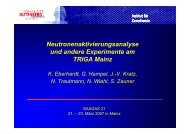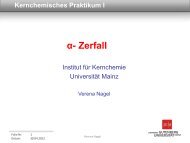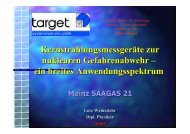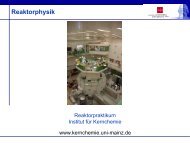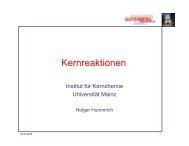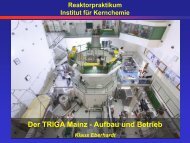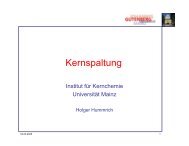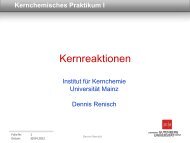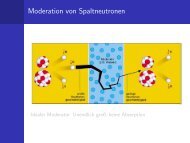institut für kernchemie universität mainz jahresbericht 2009
institut für kernchemie universität mainz jahresbericht 2009
institut für kernchemie universität mainz jahresbericht 2009
Create successful ePaper yourself
Turn your PDF publications into a flip-book with our unique Google optimized e-Paper software.
Elution of 68 Ge/ 68 Ga radionuclide generators in “reverse” mode<br />
N. S. Loktionova, F. Rösch<br />
Institute of Nuclear Chemistry, Johannes Gutenberg-University Mainz, D-55128 Mainz, Germany<br />
Introduction: The 68 Ge/ 68 Ga radionuclide generator<br />
provides an excellent source of positron emitting 68 Ga<br />
for the routine synthesis and application of 68 Galabeled<br />
compounds using PET. The eluates show a<br />
breakthrough of 68 Ge of 10 -3 to 10 -2 %, increasing with<br />
time or usage frequency, and impurities such as stable<br />
Zn II generated by the decay of 68 Ga, Ti IV a constituent<br />
of the 68 Ge adsorption column material and Fe III as a<br />
general impurity.<br />
Recently the “reverse” mode of elution for the 44 Ti/ 44 Sc<br />
radionuclide generator was investigated [1]. Here we<br />
report the evaluation and comparative study of two<br />
different modes of elution for the 68 Ge/ 68 Ga generator.<br />
Experimental: A commercial generator based on a<br />
TiO2 phase adsorbing 68 Ge IV was obtained from<br />
Cyclotron Co. Ltd. In the present study, a 300 MBqdevice<br />
was used. The generator was washed with 10 ml<br />
0.1 M HCl solution during one week in one direction<br />
(“direct elution”). In the following week, the generator<br />
was washed with 10 ml 0.1 M HCl solution the same<br />
way (direct elution before “reverse”). However,<br />
immediately after this primary elution of 68 Ga, the<br />
generator was washed with 10 ml of 0.1 N HCl in the<br />
opposite direction (“reverse elution”).. Elution of the<br />
generator was carried out three times a day. Samples<br />
were collected in 15 ml plastic vials and measured for<br />
their 68 Ga and 68 Ge content. The absolute radioactivity<br />
of 68 Ga samples was accomplished in a dose calibrator<br />
M2316 (Messelektronik Dresden GmbH). The absolute<br />
radio-activity of 68 Ge samples was measured by<br />
γ-spectro-metry using a high-purity germanium<br />
(HPGe) detector three days after elution.<br />
Results and Discussion: Figure 1 illustrates the yield<br />
of 68 Ga obtained from an increasing number of elutions<br />
of both elution modes. Figure 2 illustrates the<br />
breakthrough of 68 Ge observed in an increasing number<br />
of elutions of both elution modes.<br />
The general yield of 68 Ga did not notably change from<br />
day to day and neither within the two weeks (Fig. 1).<br />
Expectedly, in the reverse elution the 68 Ga yield was<br />
always low, representing about 10% of the initially<br />
eluted 68 Ga.<br />
Over a period of one week and 15 elution processes,<br />
the yield of 68 Ga in the direct elution and in the direct<br />
elution of the reverse mode did not significantly differ<br />
from each other.<br />
The reverse elution washes 68 Ge, which is localized on<br />
the generator column close to its breakthrough, back to<br />
a higher and “safer” position on the TiO2-matrix. This<br />
should reduce the breakthrough for the next elution.<br />
Over the 15 reverse elution processes, the 68 Ge-breakthrough<br />
in a direct elution (24 ± 4 %) following a<br />
reverse elution (16 ± 3 %) was thus reduced by 33 %.<br />
On the other hand, there was an about ten times higher<br />
“breakthrough” of 68 Ge in the reverse elution, which<br />
indicates for a strong wash-off of the 68 Ge-loading at<br />
the top of the generator column. However, the use of the<br />
“reverse” fraction from previous elution for the next<br />
direct elution should recover most of this 68 Ge-loss as it<br />
has been shown for the 44 Ti/ 44 Sc generator by the work<br />
of Filosofov et al. [1]. Alternatively, a sufficient amount<br />
of adsorbent could be installed on top of the original<br />
generator column.<br />
Yield of Ga-68 (MBq)<br />
300<br />
250<br />
200<br />
150<br />
100<br />
50<br />
0<br />
1 2 3 4 5 6 7 8 9 10 11 12 13 14 15<br />
Number of elution<br />
Fig.1. Yield of 68 Ga in the various elution modi.<br />
Breakthrough of Ge-68 (kBq)<br />
35<br />
30<br />
25<br />
20<br />
15<br />
10<br />
5<br />
0<br />
direct elution<br />
reverse elution<br />
1 2 3 4 5 6 7 8 9 10 11 12 13 14 15<br />
Number of elution<br />
direct elution<br />
reverse elution<br />
Fig. 2. Breakthrough of 68 Ge in “direct” and “reverse” elution mode.<br />
Conclusions: In this study of 15 comparative elution<br />
processes, a benefit of reduced breakthrough in the<br />
“reverse” elution mode for the 68 Ge/ 68 Ga generator of 33<br />
% could be observed.<br />
An extended study over a longer period of time including<br />
more elution processes and a reuse of the reverse elution<br />
fraction should show a beneficial effect of the reverse<br />
mode of elution also for the 68 Ge/ 68 Ga generator.<br />
In case of the 44 Ti/ 44 Sc generator an increased yield and<br />
an improved life-time of the generator has been shown<br />
over more than 50 elution processes. Furthermore, a<br />
reuse of the reverse elution fraction was applied.<br />
References:<br />
[1] D. V. Filosofov, N.S. Loktionova, F. Rösch, A 44 Ti/ 44 Sc radionuclide<br />
generator for potential application of 44 Sc-based PET-radiopharmaceuticals;<br />
Radiochimica Acta 98, 149-156 (2010)


